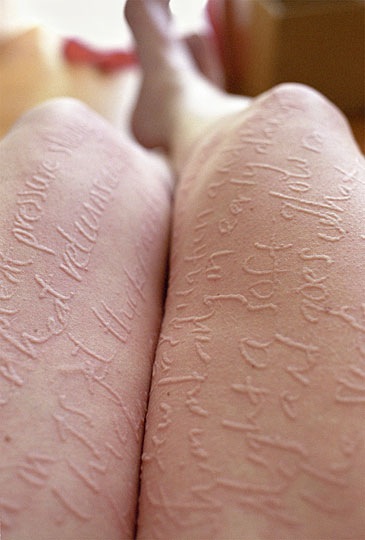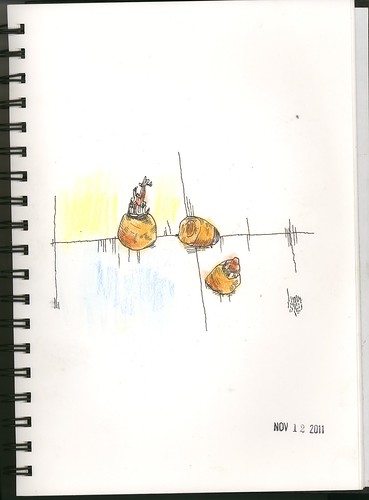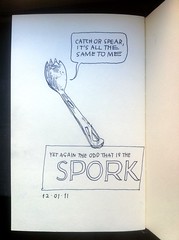Archived entries for art
The habit of the doing
Roz Wound Up: Adventures in Bookbinding: Working in the Spaces of Life:
You might think that for a task like this the best thing to do is pick a weekend and work like hell on that weekend with no distractions.
You’re wrong. Just like it is folly to think you can skip your journaling all week long and “catch up” on the weekend (first of all you can’t catch up on something that is about being in the moment) it is unlikely a big weekend push will accomplish as much as you hope. And then you’ll have to deal with the let down.
This isn’t to say you shouldn’t schedule a playdate with friends to make paste paper one weekend, or make your own bookbinding cloth by paper-backing your favorite fabrics. Those can be great and productive weekends.
What I’m saying is that when you start putting off your creative efforts until you have more time you’ll quickly find you have less time for those efforts, because other things keep stealing from those plans.
Better to steal back those times that aren’t used during the week and apply them to your creative tasks (in this example, to bookbinding).
And to do that you’ll have to develop patience. But that’s a good thing anyway. You’ll feel better about a lot of things in general, but if you develop a little patience your creative projects will really benefit because you will find yourself working in a more mindful and determined way.”
This whole post is really relevant to just about any creative endeavor you want to undertake. Full of really sharp insight. You should read it. The thing I try to remember is to remove the “magic” from creative work: it has to be done over and over again with little regard to quality or making something Great. The idea is to instill practice as a habit. Then it just becomes something you do because it’s something you do, and the attention and development grow out of that.
“decorate all these blank white pages”
Bookslut | “Beyond This Universe of Countless Wordsâ€:
While some might see this kind of writing as incoherent and lacking focus, the collage extends notions of self, memory, perception, and reflection in ways unique to Whalen’s modernist collage. Significantly, Whalen provides what Kenneth Burke has called ‘strategies for living.’ Such strategies provide readers with a richly textured poem that comments on the force of memory and imagination in the creation of everyday experience. Spiritual and philosophical introspection is often tempered with humorous outbursts of self-awareness, commentary on the concretely situated flesh-and-blood body in space, and historically framed contexts that give meaning to the accident of occasion. Such accidents appear in Whalen’s work in need of redemption from the peculiarities of chance. His work suggests instead that separation is an illusion, that things cohere as experience within a life remembered and continually re-processed and situated in the subtly shifting coordinates we all must ride. Poetry provides an imposed limitation on these phenomenal movements, for it demands translation of perception into a particularly ordered language. Again, in Burke’s terms, Whalen shows us how to expand our capacities of seeing, feeling, and thinking about the world and the particular environments we inhabit.
Particularly perceptive review of Whalen’s work in the the context of the recent Collected Poems. Whalen is by far my favorite of all the Beats. For the most part Whalen seems onto something entirely different than Kerouac Ginsberg Corso et al; his lumping in there is an accident of history.
Technorati Tags:
poetry, literature, whalen, beats
Written on the body

Ariana Page Russell has a skin disease which enables her to write and draw on her own skin:
My own skin frequently blushes and swells. I have dermatographia, a condition in which one’s immune system exhibits hypersensitivity, via skin, that releases excessive amounts of histamine, causing capillaries to dilate and welts to appear (lasting about thirty minutes) when the skin’s surface is lightly scratched. This allows me to painlessly draw patterns and words on my skin, which I then photograph.
It’s simultaneously creepy and beautiful at once.
(Via Kirsty Hall.)
A very small Wacom
Colors! is a simplistic digital application for Nintendo DS based on modern painting-
techniques developed for drawing tablets in programs like Photoshop. By taking
advantage of the pressure sensitivity of the DS touch-screen it becomes a perfect
portable digital sketch-book.
A reason I might want a DS, though apparently it requires some hacking to get this to run on a DS. I’d been idly thinking about getting one for things like Brain Age and the new “visual training” game Flash Focus. I’m not really a gamer, but Nintendo really seems to know how to get people like me to play their games.
Japanese manhole covers
Via Drawn, photos of manhole covers in Japan. Oddly ancient and modern at the same time.




